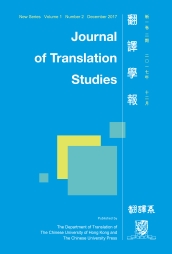 |
|
||||||||||||||||||||||||||||||||||||||||||||||||||||||||||||||||||||||||||||||||||||||||||||||||
| 「直譯」詞源考——兼論「直譯」在古漢語中的語義演變 |
|---|
| 陶磊(Lei Tao) 復旦大學 |
|
摘要 根據目前掌握的材料看,古漢語中雖然出現過「直譯」,但只是「直」和「譯」的偶然組合,並不具有語言學意義上複合詞的特徵。這些「直譯」只是「直接翻譯」的縮略語,和我們現在當作翻譯術語使用的「直譯」完全不同。而且怎樣的翻譯才算直接,也取決於具體語境。與「意譯」相對的「直譯」在二十世紀初的報章文牘中已可見到,但大體上代表一種不恰當的翻譯方法而受到批評。「直譯」一詞實際上來自日語,日語中的「直譯」係由蘭學家創製,後逐漸成為常用詞,在幕末明初出版的各類詞典中多有收錄。由於中日共用漢字系統,作為日語漢字詞的「直譯」可以通過「借形」的方式迅速進入漢語詞彙——這在十九世紀末二十世紀初的旅日學生留下的記 錄,以及梁啟超等在日本創辦的《清議報》《新民叢報》上的文章中可以得到印證。 Abstract No evidence has been found in existing literature that the word zhiyi (literal translation) has been used in ancient Chinese. It is also not common to see the combination of zhi and yi, which can be regarded as the abbreviation of “direct translation” — the understanding of “direct” always changes with the context. This kind of zhiyi is completely different from the translation term zhiyi we use nowadays. The modern Chinese word zhiyi (literal translation), opposite to yiyi translation), appeared no later than the beginning of the twentieth century. However, it was considered as an inadequate translation method then. Actually, zhiyi originated from Japanese. It was written in the form of Chinese character in Japanese, and could be found in many dictionaries from late Shogunate to early Meiji. Since Chinese and Japanese shared Chinese characters, zhiyi became a Chinese word easily by the way of “word loaning.” The “loaning” process was recorded in the notes left by Chinese students in Japan around the turn of the century, and the articles in Qingyi Newspaper and Xinmin Journal run by Liang Qichao in Japan. |
| Children of the Revolution: Conservative Reform in Zeng Pu’s Translation of Victor Hugo’s Ninety-Three |
|---|
| Robert Moore University of Oregon |
|
Abstract In 1912, the Francophile translator and novelist Zeng Pu 曾樸 published his translation of Victor Hugo’s final novel, Ninety-Three. Zeng significantly altered the text, changing the focus of several key sections, and leaving out a thirty-page chapter entirely. What seems like a disregard for Hugo’s novel is in fact the demonstration of a different perspective on the goal of translation. For Zeng Pu, translation was a reformative technology, one that worked to directly affect the readers’ hermeneutic protocols such that through the experience of the translated narrative, they were brought to read and see the world around them in a manner cognizant with the concerns of the translator. In service to that, the translator’s responsibility was to consciously alter the text such that a new, and in Zeng Pu’s case socially transformative, set of hermeneutic skills was fostered. This paper explores Zeng Pu’s overall philosophy on translated literature, both through later writings and through a close reading of several key changes made to Hugo’s text, and poses the question of how we are to study an approach to translation that does not believe in the fidelity of the source text. |
| Relay Translation of Feminism in China: An Intralingual Case |
|---|
| Zhongli Yu University of Nottingham Ningbo China |
|
Abstract Relay translation is generally understood as the translation of a translated text, spoken or written, into a third language (St. André 2009, 230). It has been widely used in intercultural exchange in history. However, due to worries about greater distortion of or deviation from the ultimate source text, there has been widespread aversion to its practice. This partly explains why “very few dispassionate studies” on it have been carried out (Washbourne 2013, 609). Moreover, the existing studies pay more attention to problems in relay translation and tend to be very restrictive in defining the concept, either wittingly or unwittingly, excluding intralingual and intersemiotic translation. This paper investigates an intralingual case of relay translation through examining the Chinese productions at Fudan University of the radical feminist play The Vagina Monologues (Ensler 1998). However, this paper is not so much about relay translation as it is commonly understood. It explores the translation of a translated text into different translations of the text in the source language, focusing on the translators’ behavior in the specific social context, particularly the strategies for dealing with the constraints from the social context and cultural differences. The constraints resulted in remarkable manipulations in the Fudan productions for more effective communication with the audience and for better reception in the target context. The manipulations discussed under the rubric of relevance will demonstrate both differences and interconnections among the Fudan productions, the mediating texts, and the source text, revealing the complexity of translating Western feminism in China as well as the complexity of relay translation. |
| Translating Cities: W. H. Auden and 1940s Chinese Metropolis Poetry |
|---|
| Qiang Zhang Nankai University |
|
Abstract This paper focuses on the creation of the image of cities in W. H. Auden’s poetry and how these images relate to Chinese poetry in the 1940s when used archetypally. Mu Dan’s poetry is the primary example. The construction of cities in Auden’s poems is based on two-dimensional hierarchies, namely, the disparity between ancient Western cities in their heroic glory and modern Western cities in their moral degeneration, as well as the sharp binary opposition between Western cities of colonial powers and the marginalized cities of the Orient. In the context of national salvation in 1940s China, this paper sees the description of cities in Chinese poems, especially those by the Nine Leaves School, as more than a rewriting and translation of Auden’s poems. The hybridity both in form and in content, on the one hand, shows the inevitable trend of poetic modernity in urban writings; on the other hand, it also manifests the desire of Chinese poets in search of a discourse that embraces both Western and Chinese culture by focusing on their shared fate under the grand sociohistorical background of World War II. |



